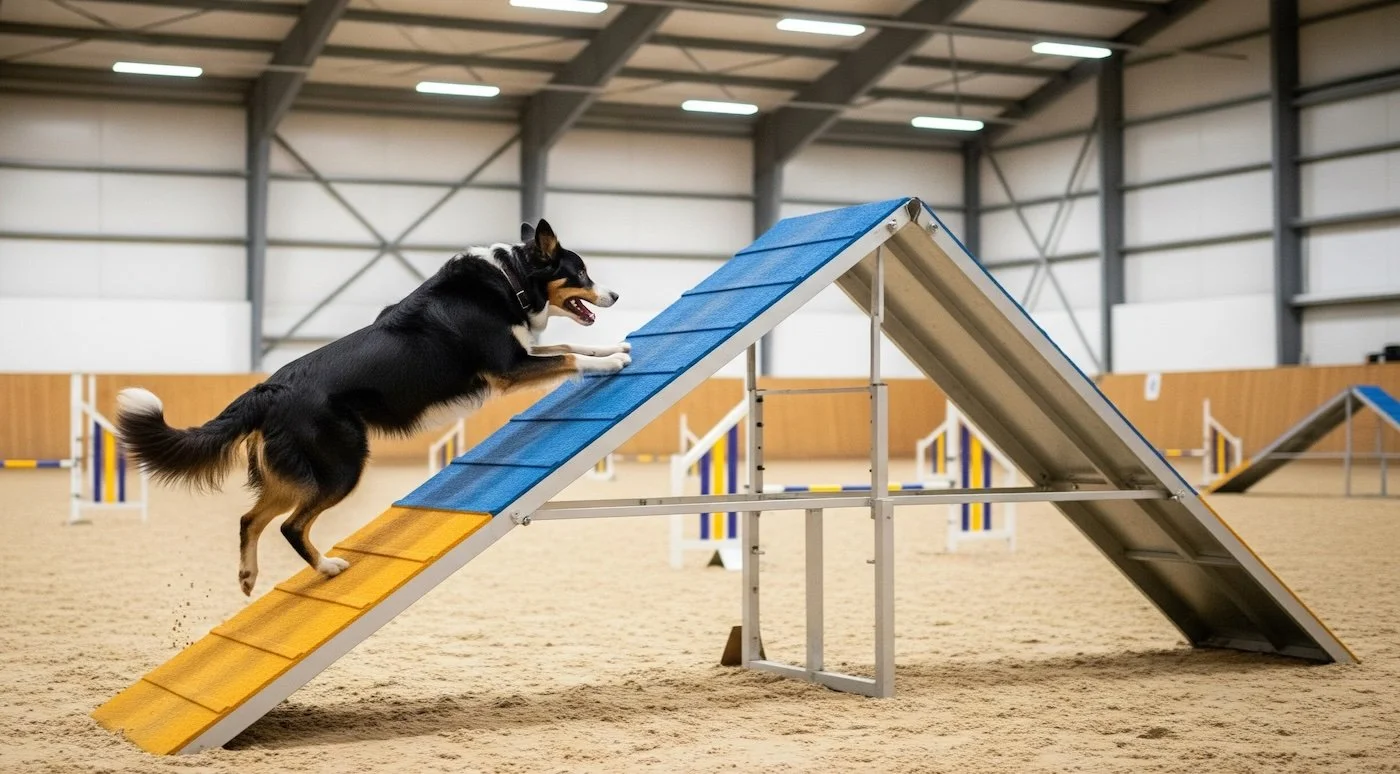Contact zones are designed to ensure dogs safely transition on and off the A-frame. Missing them can lead to faults in competition or even injuries. That’s why consistent contact behavior is one of the most important skills in agility training.
Tips for contact zone mastery on A-frame
1. Start with a clear goal
When training the A-frame, it’s essential to begin with a well-defined goal. For many agility teams, running contacts are the preferred method. This approach allows the dog to maintain speed while still making accurate contact at the bottom of the A-frame.
Running contacts require careful stride regulation and consistent reinforcement. The goal is to teach the dog to naturally hit the contact zone without needing to pause or slow down. This method is especially beneficial for high-drive dogs or those competing at advanced levels, where speed and flow are critical.
2. Use target mats or visual markers
To train running contacts effectively:
Use target mats or stride regulators to guide foot placement.
Reinforce correct behavior with precise reward timing—ideally delivered while the dog is still in motion.
Start with a lowered A-frame and gradually increase the height as your dog gains confidence and consistency.
By committing to running contacts from the start, you create a clear and consistent training path that supports both performance and safety.
3. Train controlled descents
Even when aiming for running contacts, it’s important to teach your dog how to descend the A-frame in a controlled and balanced manner. Large and fast dogs, in particular, can easily overshoot the contact zone if they don’t learn to regulate their stride.
By using stride regulators to help your dog develop a consistent rhythm as they move down the ramp.
Use 1-2 regulators based on your dog's size and training goal. Adjust placement as your dog progresses.
To optimize your dog's stride on the A-frame:
Place a regulator near the apex to encourage them to stride cleanly over the top.
Position one midway down the descending side to help them collect their stride before the contact.
A regulator lower down, near the contact zone, can aid in teaching proper contact landing.
You can also use a target mat at the base of the A-frame to reinforce the correct landing zone.
4. Reward precisely
For running contacts, reward timing is everything. Reinforce your dog the moment they hit the contact zone - ideally while still moving. Use tossed toys or treats just beyond the A-frame to encourage forward motion. Avoid rewarding if your dog misses the zone or slows down too much, as this can reinforce the wrong behavior.
5. Build confidence gradually
Confidence is key to successful running contacts. Start with a lowered A-frame to help your dog get comfortable with the structure and movement. As consistency improves, gradually raise the height while maintaining the same contact expectations.
Keep sessions short and focused, and always reward when your dog hits the contact zone cleanly while maintaining forward motion.
Bonus: What not to do
Don’t start your dog too close to the A-frame - give them room to build momentum.
Don’t rush to full-height training.
Don’t ignore signs of hesitation or fear- these are cues to slow down and reinforce confidence.
Training approaches for the A-frame - especially for contact zone behavior -should be adjusted based on the size of the dog. Here's why and how you might tailor your training for small, medium, and large dogs:
🐾 Small Dogs
Why it matters: Small dogs often lack the momentum to naturally reach the contact zone unless trained deliberately.
Training focus:
Use lowered A-frames to build confidence.
Reinforce clear, deliberate contact behavior early.
Keep sessions short to avoid fatigue, especially on inclines.
Position stride regulators closer together to encourage the increased number of steps.
🐕 Medium Dogs
Why it matters: Medium dogs are often the most versatile but can develop bad habits if not consistently reinforced.
Training focus:
Maintain consistent criteria—they may try to “cheat” the contact zone if they can jump it.
Use target mats and reward timing to reinforce correct behavior.
Introduce sequencing earlier to test reliability under distraction.
🐕🦺 Large Dogs
Why it matters: Large dogs have more momentum and are at greater risk of injury if they leap off the A-frame.
Training focus:
Prioritize controlled descent and running contacts with stride regulation.
Use longer approach distances to manage speed.
With longer strides using regulators, larger dogs often aim for a "three-stride A-frame": one stride up, one over the apex, and one down into the contact zone.
Consider impact-reducing surfaces and limit repetitions to protect joints.
Summary
Contact zone training is about more than just hitting a colored patch - it’s about building a reliable, safe, and confident performance. With thoughtful planning, consistent reinforcement, and a clear training path, your dog will not only master the A-frame but enjoy every step of the climb.

